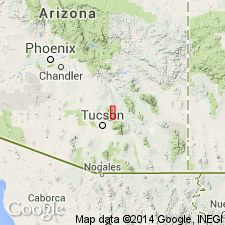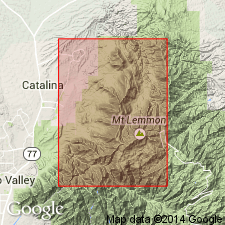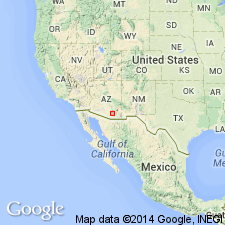
- Usage in publication:
-
- Catalina granite
- Modifications:
-
- First used
- Dominant lithology:
-
- Granite
- AAPG geologic province:
-
- Basin-and-Range province
Summary:
First published use of name; name attributed to Moore and others (1949); derivation of name not stated. [In references the only citation to Moore and others is "Geology of Tucson quadrangle, AZ, U.S. Geological Survey Open File Report" (1941).] Intent to name in this report not stated. Occurs north of Mount Lemmon within Santa Catalina Mountains Pima Co, AZ (Basin-and-Range province). Dikes and apophyses of this granite intrude post-Cretaceous Leatherwood quartz diorite. Displays chilled contacts. Consists of two facies. Northern exposures are granodiorite in composition, hypidiomorphic granular in texture, and contain mainly quartz, orthoclase, and oligoclase. Southern exposures consist of granite with crystalloblastic texture, composed of abundant quartz and orthoclase with some plagioclase and biotite. Features of southern exposures suggest metasomatic replacement of metasediments forming granite; features of northern exposures seem related to mobilization of granitic materials that may or may not have been completely molten. (Author also uses name "Catalina gneiss" to describe Precambrian gneissic rocks that make up core of Santa Catalina Mountains and extend southeastward from Mount Lemmon into Tanque Verde and Rincon Mountains.) Catalina granite is shown on map (fig. 46, p. 218) as Tertiary age.
Source: GNU records (USGS DDS-6; Denver GNULEX).

- Usage in publication:
-
- Catalina Granite
- Modifications:
-
- Overview
- AAPG geologic province:
-
- Basin-and-Range province
Summary:
Catalina Granite forms a 30 square km pluton exposed on west flank of Santa Catalina Mountains, east of community of Catalina, Pima Co, AZ (Basin-and-Range province). Unit is mostly lacking cataclastic textures and where contacts with other rocks are observable, they are sharp cross-cutting contacts. Similar appearance to Oracle Granite (Precambrian) led earlier workers to include Catalina with Oracle; error included on the 1969 Geologic Map of Arizona. Consists of hornblende biotite quartz monzonite with abundant, large (up to 8 mm diameter) brown sphene crystals. U-Th-Pb analyses of zircons from Catalina at Golder Dam spillway yield an emplacement age of 28 m.y. (age first reported in Shakel and others, 1977, GSA, Abs, v.9, 1169-1170). Author also uses name "Catalina Gneiss" for a separate group of rocks. [The same name should not be used for different units (Art. 7b, 1983 Code).]
Source: GNU records (USGS DDS-6; Denver GNULEX).

- Usage in publication:
-
- Catalina quartz monzonite
- Modifications:
-
- Areal extent
- Overview
- Geochronologic dating
- Redescribed
- Dominant lithology:
-
- Quartz monzonite
- AAPG geologic province:
-
- Basin-and-Range province
Summary:
Redescribed as quartz monzonite (modal analyses, table 5). Forms large, half-circle-shaped pluton in northwestern Santa Catalina Mountains and an east-northeast-trending dike-like mass in south-central Tortolita Mountains, Pima Co, AZ (Basin-and-Range province). Is one of four plutons comprising "Catalina suite" (others are Reef of Rock granite and Tortolita, and provisionally, Happy Valley quartz monzonites); "Catalina suite" is one of three post-Paleozoic suites of intrusive bodies in Santa Catalina-Rincon-Tortolita crystalline complex of southeastern AZ (others are Leatherwood and Wilderness suites). Catalina quartz monzonite, largest pluton of "Catalina suite," has been confused with Precambrian Oracle Granite. Mineralogy of Oracle and Catalina are very similar except for accessory minerals; Catalina contains hornblende and sphene which are absent in Oracle. Fossil horn coral found in limestone inclusion in Catalina by McCullough (1963, unpub. PhD. dissert., Univ. AZ); subsequent isotopic dates by other workers, and isotopic date of 26 m.y. in this report (table 1, fig. 20) establish a late Oligocene age for pluton. Unit intrudes Leatherwood quartz diorite (Late Cretaceous-early Tertiary); southern contact with Wilderness granite (Eocene) is an intrusive contact into Lemmon Rock leucogranite border phase of Wilderness. Discussion of nomenclature (appendix 1).
Source: GNU records (USGS DDS-6; Denver GNULEX).
For more information, please contact Nancy Stamm, Geologic Names Committee Secretary.
Asterisk (*) indicates published by U.S. Geological Survey authors.
"No current usage" (†) implies that a name has been abandoned or has fallen into disuse. Former usage and, if known, replacement name given in parentheses ( ).
Slash (/) indicates name conflicts with nomenclatural guidelines (CSN, 1933; ACSN, 1961, 1970; NACSN, 1983, 2005, 2021). May be explained within brackets ([ ]).

